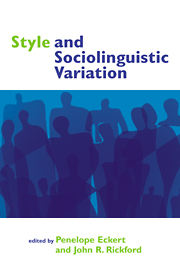Book contents
- Frontmatter
- Contents
- List of figures
- List of tables
- List of contributors
- Acknowledgments
- Introduction: John R. Rickford and Penelope Eckert
- Part I Anthropological approaches
- Part 2 Attention paid to speech
- 5 The anatomy of style-shifting
- 6 A dissection of style-shifting
- 7 Style and social meaning
- 8 Zeroing in on multifunctionality and style
- Part 3 Audience design and self-identification
- Part 4 Functionally motivated situational variation
- References
- Index
5 - The anatomy of style-shifting
Published online by Cambridge University Press: 07 December 2009
- Frontmatter
- Contents
- List of figures
- List of tables
- List of contributors
- Acknowledgments
- Introduction: John R. Rickford and Penelope Eckert
- Part I Anthropological approaches
- Part 2 Attention paid to speech
- 5 The anatomy of style-shifting
- 6 A dissection of style-shifting
- 7 Style and social meaning
- 8 Zeroing in on multifunctionality and style
- Part 3 Audience design and self-identification
- Part 4 Functionally motivated situational variation
- References
- Index
Summary
Taxonomies of style and their uses
The development of sociolinguistic methodology has witnessed a continual tension between two approaches to contextual style: style-shifting as a naturalistic, ethnographic phenomenon, and style-shifting as a controlled device for measuring the dynamics of sociolinguistic variation. In many ways, the naturalistic approach is the most immediately appealing and satisfying. We would like to know as much as possible about the ways that speakers shift forms and frequencies in the course of every-day life. Styleshifting seems to be one of the keys to what we now see as the central problem of the theory of language change: the transmission problem. In the course of linguistic change, children learn to speak differently from their parents, and in the same direction that their parents learned to talk differently from their own parents. To trace this post-vernacular reorganization, we will need to record the dynamic inter-play between speakers and their styles in the social setttings of most significance to their life chances. The kinds of data needed are very exacting: high quality recordings with minimum obtrusiveness of group interactions in which a well-known individual interacts with a variety of interlocutors and social situations (Hindle 1980, Cukor-Avila 1995, Coupland 1980, Bell 1984).
The difficulty of obtaining such data means that we cannot reasonably expect to obtain a representative sample of style-shifting for an entire community by this means. The most solid and replicable findings of sociolinguistics so far rest on representative studies of communities through comparable interviews, and in most cases, this involves the close study of stylistic differences within the interview, that is, intra-speaker variation where the interlocutors and the social situation are roughly constant.
- Type
- Chapter
- Information
- Style and Sociolinguistic Variation , pp. 85 - 108Publisher: Cambridge University PressPrint publication year: 2002
- 22
- Cited by

